Assessing High Technology's Influence on Consumer Behavior: Report
VerifiedAdded on 2020/10/23
|20
|5730
|269
Report
AI Summary
This report investigates the significant influence of high technology and knowledge on consumer behavior. It delves into how advancements in technology, including the internet, social media, and e-commerce, have reshaped consumer habits, purchasing decisions, and brand awareness. The report explores the role of technology in generating awareness, the importance of knowledge in buying products, and the overall dynamics of consumer behavior. It examines the impact of these factors on consumer decision-making, brand loyalty, and the evolving relationship between businesses and their customers. The research methodology includes literature review, and the report highlights the challenges and opportunities for businesses in adapting to the changing consumer landscape. This analysis provides valuable insights into the factors influencing consumer behavior in the digital age and the implications for marketing strategies.
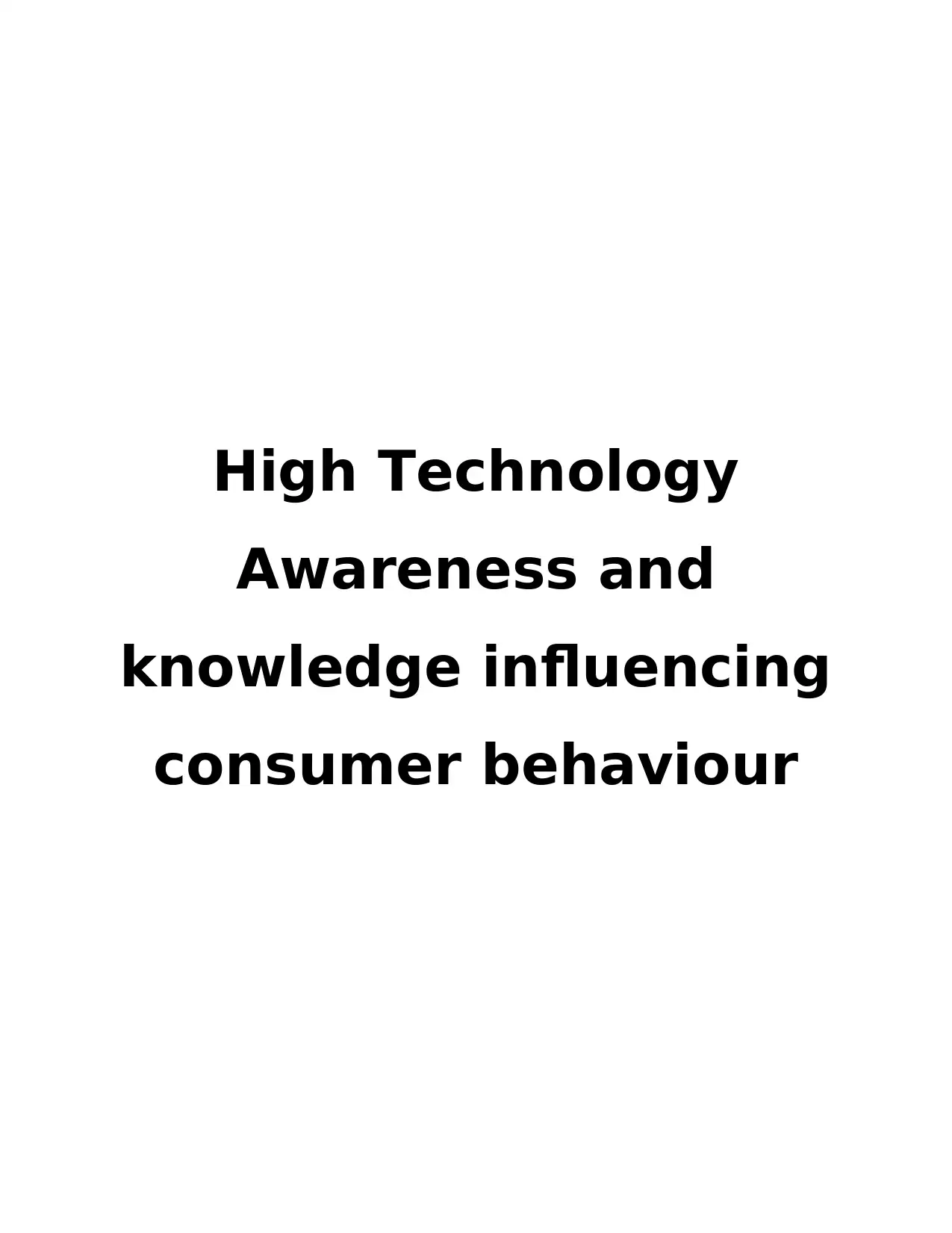
High Technology
Awareness and
knowledge influencing
consumer behaviour
Awareness and
knowledge influencing
consumer behaviour
Paraphrase This Document
Need a fresh take? Get an instant paraphrase of this document with our AI Paraphraser
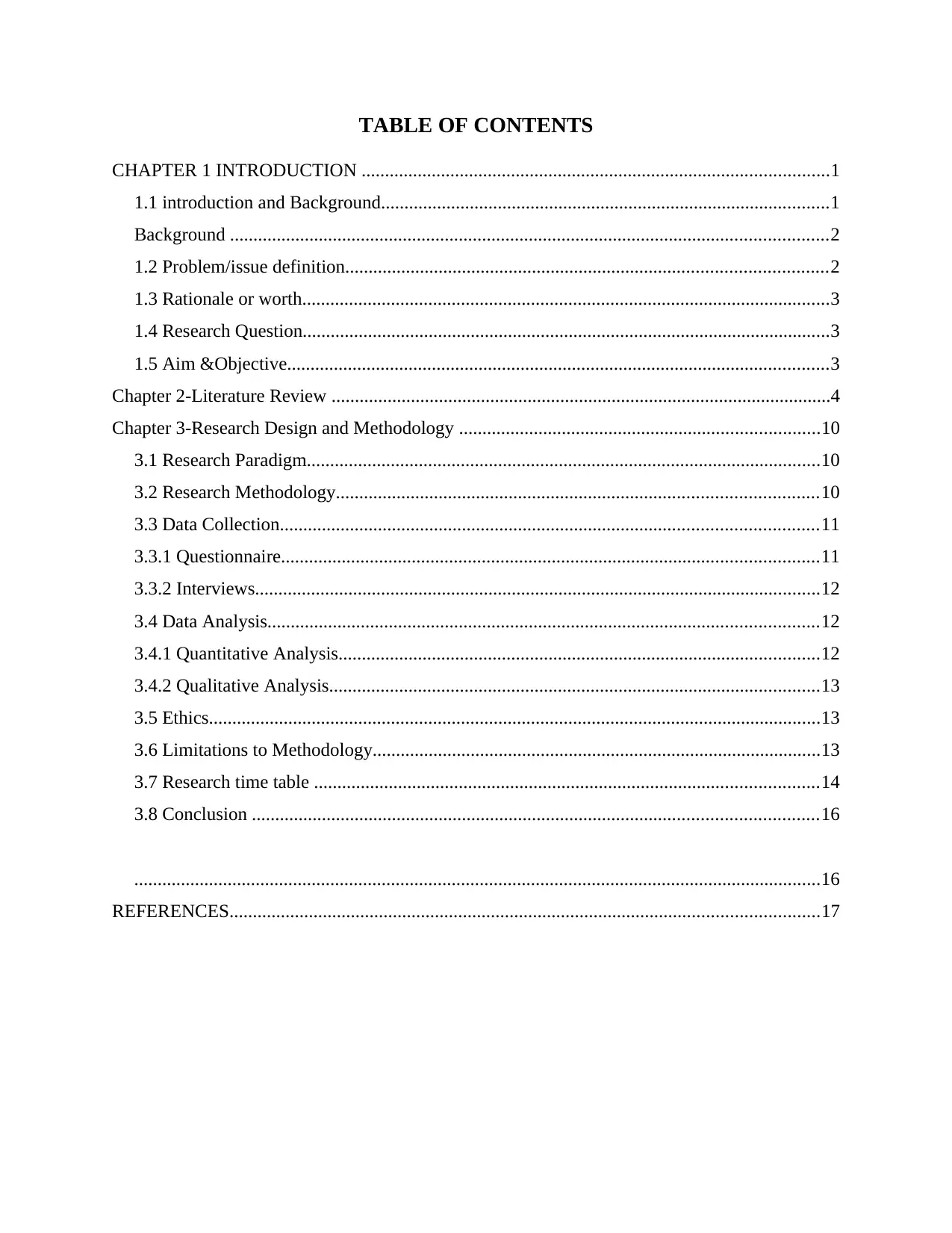
TABLE OF CONTENTS
CHAPTER 1 INTRODUCTION ....................................................................................................1
1.1 introduction and Background................................................................................................1
Background ................................................................................................................................2
1.2 Problem/issue definition.......................................................................................................2
1.3 Rationale or worth.................................................................................................................3
1.4 Research Question.................................................................................................................3
1.5 Aim &Objective....................................................................................................................3
Chapter 2-Literature Review ...........................................................................................................4
Chapter 3-Research Design and Methodology .............................................................................10
3.1 Research Paradigm..............................................................................................................10
3.2 Research Methodology.......................................................................................................10
3.3 Data Collection...................................................................................................................11
3.3.1 Questionnaire...................................................................................................................11
3.3.2 Interviews.........................................................................................................................12
3.4 Data Analysis......................................................................................................................12
3.4.1 Quantitative Analysis.......................................................................................................12
3.4.2 Qualitative Analysis.........................................................................................................13
3.5 Ethics...................................................................................................................................13
3.6 Limitations to Methodology................................................................................................13
3.7 Research time table ............................................................................................................14
3.8 Conclusion .........................................................................................................................16
...................................................................................................................................................16
REFERENCES..............................................................................................................................17
CHAPTER 1 INTRODUCTION ....................................................................................................1
1.1 introduction and Background................................................................................................1
Background ................................................................................................................................2
1.2 Problem/issue definition.......................................................................................................2
1.3 Rationale or worth.................................................................................................................3
1.4 Research Question.................................................................................................................3
1.5 Aim &Objective....................................................................................................................3
Chapter 2-Literature Review ...........................................................................................................4
Chapter 3-Research Design and Methodology .............................................................................10
3.1 Research Paradigm..............................................................................................................10
3.2 Research Methodology.......................................................................................................10
3.3 Data Collection...................................................................................................................11
3.3.1 Questionnaire...................................................................................................................11
3.3.2 Interviews.........................................................................................................................12
3.4 Data Analysis......................................................................................................................12
3.4.1 Quantitative Analysis.......................................................................................................12
3.4.2 Qualitative Analysis.........................................................................................................13
3.5 Ethics...................................................................................................................................13
3.6 Limitations to Methodology................................................................................................13
3.7 Research time table ............................................................................................................14
3.8 Conclusion .........................................................................................................................16
...................................................................................................................................................16
REFERENCES..............................................................................................................................17
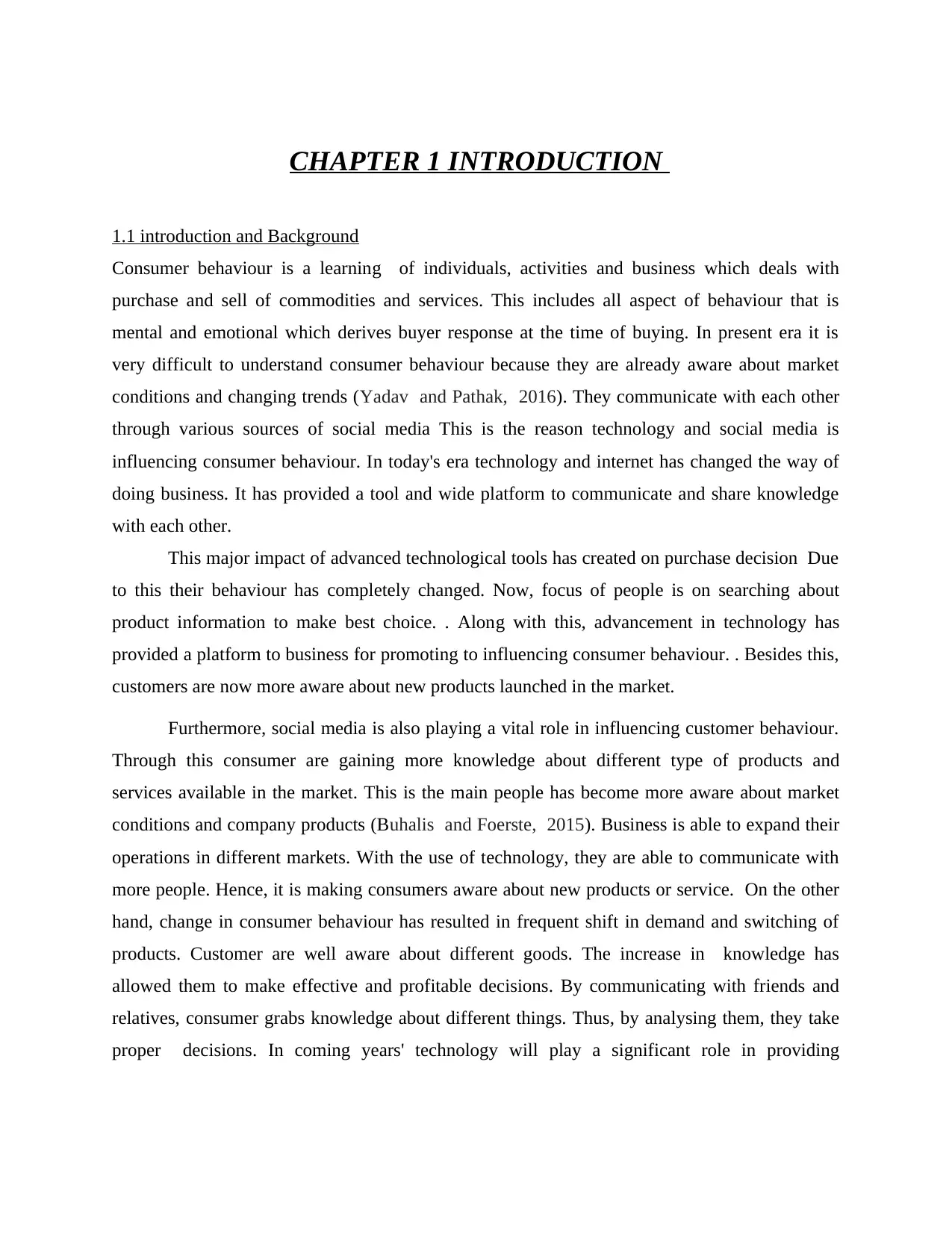
CHAPTER 1 INTRODUCTION
1.1 introduction and Background
Consumer behaviour is a learning of individuals, activities and business which deals with
purchase and sell of commodities and services. This includes all aspect of behaviour that is
mental and emotional which derives buyer response at the time of buying. In present era it is
very difficult to understand consumer behaviour because they are already aware about market
conditions and changing trends (Yadav and Pathak, 2016). They communicate with each other
through various sources of social media This is the reason technology and social media is
influencing consumer behaviour. In today's era technology and internet has changed the way of
doing business. It has provided a tool and wide platform to communicate and share knowledge
with each other.
This major impact of advanced technological tools has created on purchase decision Due
to this their behaviour has completely changed. Now, focus of people is on searching about
product information to make best choice. . Along with this, advancement in technology has
provided a platform to business for promoting to influencing consumer behaviour. . Besides this,
customers are now more aware about new products launched in the market.
Furthermore, social media is also playing a vital role in influencing customer behaviour.
Through this consumer are gaining more knowledge about different type of products and
services available in the market. This is the main people has become more aware about market
conditions and company products (Buhalis and Foerste, 2015). Business is able to expand their
operations in different markets. With the use of technology, they are able to communicate with
more people. Hence, it is making consumers aware about new products or service. On the other
hand, change in consumer behaviour has resulted in frequent shift in demand and switching of
products. Customer are well aware about different goods. The increase in knowledge has
allowed them to make effective and profitable decisions. By communicating with friends and
relatives, consumer grabs knowledge about different things. Thus, by analysing them, they take
proper decisions. In coming years' technology will play a significant role in providing
1.1 introduction and Background
Consumer behaviour is a learning of individuals, activities and business which deals with
purchase and sell of commodities and services. This includes all aspect of behaviour that is
mental and emotional which derives buyer response at the time of buying. In present era it is
very difficult to understand consumer behaviour because they are already aware about market
conditions and changing trends (Yadav and Pathak, 2016). They communicate with each other
through various sources of social media This is the reason technology and social media is
influencing consumer behaviour. In today's era technology and internet has changed the way of
doing business. It has provided a tool and wide platform to communicate and share knowledge
with each other.
This major impact of advanced technological tools has created on purchase decision Due
to this their behaviour has completely changed. Now, focus of people is on searching about
product information to make best choice. . Along with this, advancement in technology has
provided a platform to business for promoting to influencing consumer behaviour. . Besides this,
customers are now more aware about new products launched in the market.
Furthermore, social media is also playing a vital role in influencing customer behaviour.
Through this consumer are gaining more knowledge about different type of products and
services available in the market. This is the main people has become more aware about market
conditions and company products (Buhalis and Foerste, 2015). Business is able to expand their
operations in different markets. With the use of technology, they are able to communicate with
more people. Hence, it is making consumers aware about new products or service. On the other
hand, change in consumer behaviour has resulted in frequent shift in demand and switching of
products. Customer are well aware about different goods. The increase in knowledge has
allowed them to make effective and profitable decisions. By communicating with friends and
relatives, consumer grabs knowledge about different things. Thus, by analysing them, they take
proper decisions. In coming years' technology will play a significant role in providing
⊘ This is a preview!⊘
Do you want full access?
Subscribe today to unlock all pages.

Trusted by 1+ million students worldwide
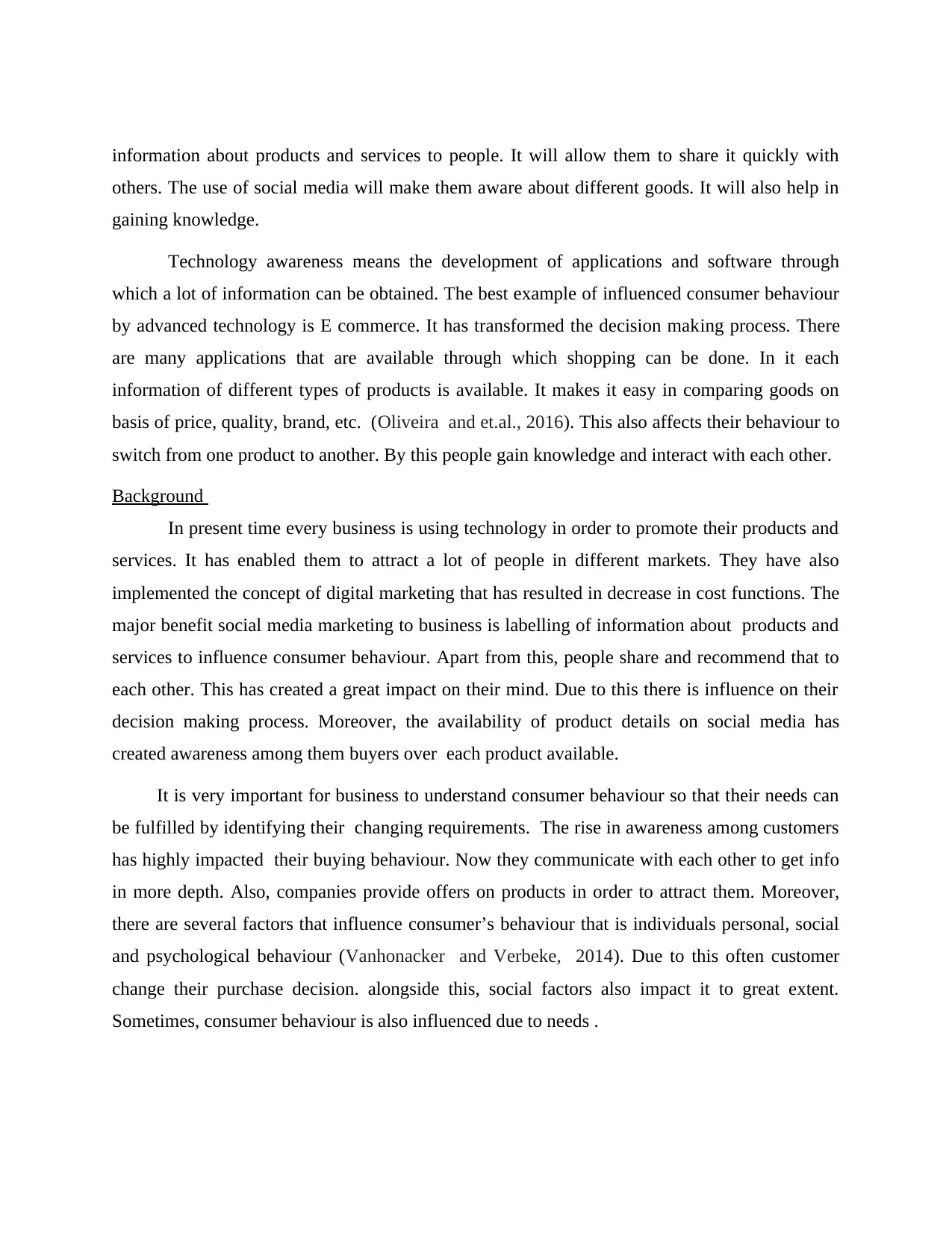
information about products and services to people. It will allow them to share it quickly with
others. The use of social media will make them aware about different goods. It will also help in
gaining knowledge.
Technology awareness means the development of applications and software through
which a lot of information can be obtained. The best example of influenced consumer behaviour
by advanced technology is E commerce. It has transformed the decision making process. There
are many applications that are available through which shopping can be done. In it each
information of different types of products is available. It makes it easy in comparing goods on
basis of price, quality, brand, etc. (Oliveira and et.al., 2016). This also affects their behaviour to
switch from one product to another. By this people gain knowledge and interact with each other.
Background
In present time every business is using technology in order to promote their products and
services. It has enabled them to attract a lot of people in different markets. They have also
implemented the concept of digital marketing that has resulted in decrease in cost functions. The
major benefit social media marketing to business is labelling of information about products and
services to influence consumer behaviour. Apart from this, people share and recommend that to
each other. This has created a great impact on their mind. Due to this there is influence on their
decision making process. Moreover, the availability of product details on social media has
created awareness among them buyers over each product available.
It is very important for business to understand consumer behaviour so that their needs can
be fulfilled by identifying their changing requirements. The rise in awareness among customers
has highly impacted their buying behaviour. Now they communicate with each other to get info
in more depth. Also, companies provide offers on products in order to attract them. Moreover,
there are several factors that influence consumer’s behaviour that is individuals personal, social
and psychological behaviour (Vanhonacker and Verbeke, 2014). Due to this often customer
change their purchase decision. alongside this, social factors also impact it to great extent.
Sometimes, consumer behaviour is also influenced due to needs .
others. The use of social media will make them aware about different goods. It will also help in
gaining knowledge.
Technology awareness means the development of applications and software through
which a lot of information can be obtained. The best example of influenced consumer behaviour
by advanced technology is E commerce. It has transformed the decision making process. There
are many applications that are available through which shopping can be done. In it each
information of different types of products is available. It makes it easy in comparing goods on
basis of price, quality, brand, etc. (Oliveira and et.al., 2016). This also affects their behaviour to
switch from one product to another. By this people gain knowledge and interact with each other.
Background
In present time every business is using technology in order to promote their products and
services. It has enabled them to attract a lot of people in different markets. They have also
implemented the concept of digital marketing that has resulted in decrease in cost functions. The
major benefit social media marketing to business is labelling of information about products and
services to influence consumer behaviour. Apart from this, people share and recommend that to
each other. This has created a great impact on their mind. Due to this there is influence on their
decision making process. Moreover, the availability of product details on social media has
created awareness among them buyers over each product available.
It is very important for business to understand consumer behaviour so that their needs can
be fulfilled by identifying their changing requirements. The rise in awareness among customers
has highly impacted their buying behaviour. Now they communicate with each other to get info
in more depth. Also, companies provide offers on products in order to attract them. Moreover,
there are several factors that influence consumer’s behaviour that is individuals personal, social
and psychological behaviour (Vanhonacker and Verbeke, 2014). Due to this often customer
change their purchase decision. alongside this, social factors also impact it to great extent.
Sometimes, consumer behaviour is also influenced due to needs .
Paraphrase This Document
Need a fresh take? Get an instant paraphrase of this document with our AI Paraphraser
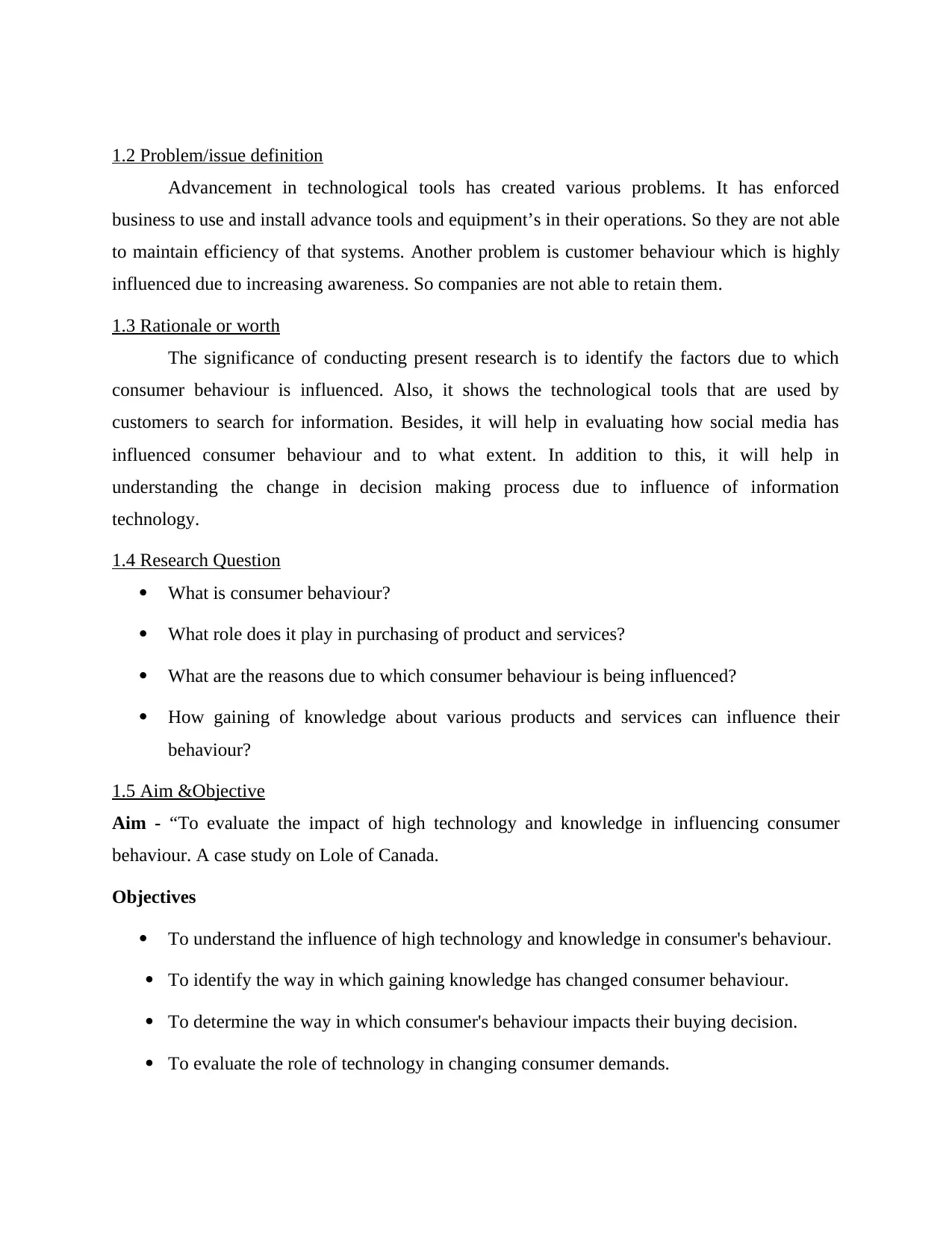
1.2 Problem/issue definition
Advancement in technological tools has created various problems. It has enforced
business to use and install advance tools and equipment’s in their operations. So they are not able
to maintain efficiency of that systems. Another problem is customer behaviour which is highly
influenced due to increasing awareness. So companies are not able to retain them.
1.3 Rationale or worth
The significance of conducting present research is to identify the factors due to which
consumer behaviour is influenced. Also, it shows the technological tools that are used by
customers to search for information. Besides, it will help in evaluating how social media has
influenced consumer behaviour and to what extent. In addition to this, it will help in
understanding the change in decision making process due to influence of information
technology.
1.4 Research Question
What is consumer behaviour?
What role does it play in purchasing of product and services?
What are the reasons due to which consumer behaviour is being influenced?
How gaining of knowledge about various products and services can influence their
behaviour?
1.5 Aim &Objective
Aim - “To evaluate the impact of high technology and knowledge in influencing consumer
behaviour. A case study on Lole of Canada.
Objectives
To understand the influence of high technology and knowledge in consumer's behaviour.
To identify the way in which gaining knowledge has changed consumer behaviour.
To determine the way in which consumer's behaviour impacts their buying decision.
To evaluate the role of technology in changing consumer demands.
Advancement in technological tools has created various problems. It has enforced
business to use and install advance tools and equipment’s in their operations. So they are not able
to maintain efficiency of that systems. Another problem is customer behaviour which is highly
influenced due to increasing awareness. So companies are not able to retain them.
1.3 Rationale or worth
The significance of conducting present research is to identify the factors due to which
consumer behaviour is influenced. Also, it shows the technological tools that are used by
customers to search for information. Besides, it will help in evaluating how social media has
influenced consumer behaviour and to what extent. In addition to this, it will help in
understanding the change in decision making process due to influence of information
technology.
1.4 Research Question
What is consumer behaviour?
What role does it play in purchasing of product and services?
What are the reasons due to which consumer behaviour is being influenced?
How gaining of knowledge about various products and services can influence their
behaviour?
1.5 Aim &Objective
Aim - “To evaluate the impact of high technology and knowledge in influencing consumer
behaviour. A case study on Lole of Canada.
Objectives
To understand the influence of high technology and knowledge in consumer's behaviour.
To identify the way in which gaining knowledge has changed consumer behaviour.
To determine the way in which consumer's behaviour impacts their buying decision.
To evaluate the role of technology in changing consumer demands.
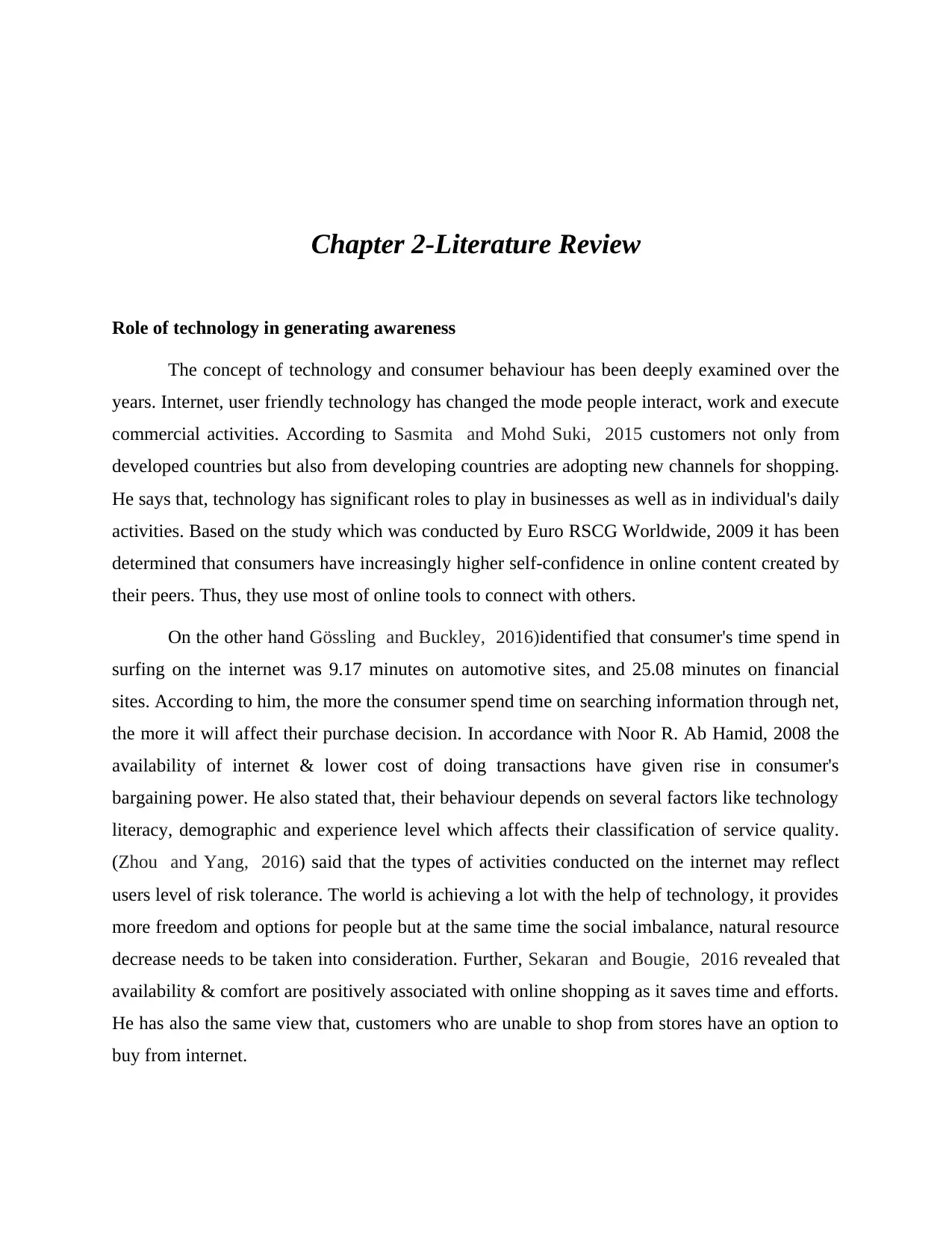
Chapter 2-Literature Review
Role of technology in generating awareness
The concept of technology and consumer behaviour has been deeply examined over the
years. Internet, user friendly technology has changed the mode people interact, work and execute
commercial activities. According to Sasmita and Mohd Suki, 2015 customers not only from
developed countries but also from developing countries are adopting new channels for shopping.
He says that, technology has significant roles to play in businesses as well as in individual's daily
activities. Based on the study which was conducted by Euro RSCG Worldwide, 2009 it has been
determined that consumers have increasingly higher self-confidence in online content created by
their peers. Thus, they use most of online tools to connect with others.
On the other hand Gössling and Buckley, 2016)identified that consumer's time spend in
surfing on the internet was 9.17 minutes on automotive sites, and 25.08 minutes on financial
sites. According to him, the more the consumer spend time on searching information through net,
the more it will affect their purchase decision. In accordance with Noor R. Ab Hamid, 2008 the
availability of internet & lower cost of doing transactions have given rise in consumer's
bargaining power. He also stated that, their behaviour depends on several factors like technology
literacy, demographic and experience level which affects their classification of service quality.
(Zhou and Yang, 2016) said that the types of activities conducted on the internet may reflect
users level of risk tolerance. The world is achieving a lot with the help of technology, it provides
more freedom and options for people but at the same time the social imbalance, natural resource
decrease needs to be taken into consideration. Further, Sekaran and Bougie, 2016 revealed that
availability & comfort are positively associated with online shopping as it saves time and efforts.
He has also the same view that, customers who are unable to shop from stores have an option to
buy from internet.
Role of technology in generating awareness
The concept of technology and consumer behaviour has been deeply examined over the
years. Internet, user friendly technology has changed the mode people interact, work and execute
commercial activities. According to Sasmita and Mohd Suki, 2015 customers not only from
developed countries but also from developing countries are adopting new channels for shopping.
He says that, technology has significant roles to play in businesses as well as in individual's daily
activities. Based on the study which was conducted by Euro RSCG Worldwide, 2009 it has been
determined that consumers have increasingly higher self-confidence in online content created by
their peers. Thus, they use most of online tools to connect with others.
On the other hand Gössling and Buckley, 2016)identified that consumer's time spend in
surfing on the internet was 9.17 minutes on automotive sites, and 25.08 minutes on financial
sites. According to him, the more the consumer spend time on searching information through net,
the more it will affect their purchase decision. In accordance with Noor R. Ab Hamid, 2008 the
availability of internet & lower cost of doing transactions have given rise in consumer's
bargaining power. He also stated that, their behaviour depends on several factors like technology
literacy, demographic and experience level which affects their classification of service quality.
(Zhou and Yang, 2016) said that the types of activities conducted on the internet may reflect
users level of risk tolerance. The world is achieving a lot with the help of technology, it provides
more freedom and options for people but at the same time the social imbalance, natural resource
decrease needs to be taken into consideration. Further, Sekaran and Bougie, 2016 revealed that
availability & comfort are positively associated with online shopping as it saves time and efforts.
He has also the same view that, customers who are unable to shop from stores have an option to
buy from internet.
⊘ This is a preview!⊘
Do you want full access?
Subscribe today to unlock all pages.

Trusted by 1+ million students worldwide
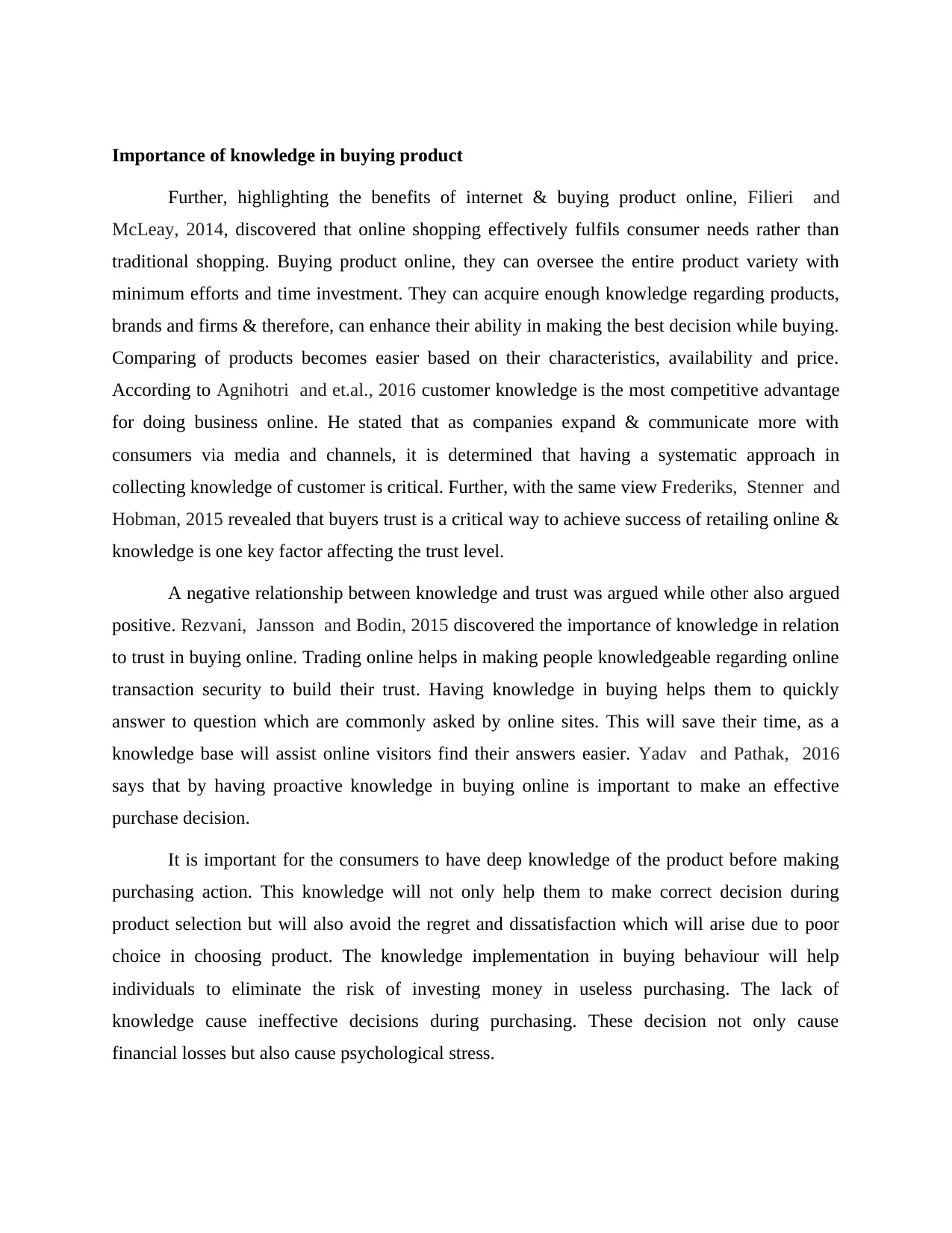
Importance of knowledge in buying product
Further, highlighting the benefits of internet & buying product online, Filieri and
McLeay, 2014, discovered that online shopping effectively fulfils consumer needs rather than
traditional shopping. Buying product online, they can oversee the entire product variety with
minimum efforts and time investment. They can acquire enough knowledge regarding products,
brands and firms & therefore, can enhance their ability in making the best decision while buying.
Comparing of products becomes easier based on their characteristics, availability and price.
According to Agnihotri and et.al., 2016 customer knowledge is the most competitive advantage
for doing business online. He stated that as companies expand & communicate more with
consumers via media and channels, it is determined that having a systematic approach in
collecting knowledge of customer is critical. Further, with the same view Frederiks, Stenner and
Hobman, 2015 revealed that buyers trust is a critical way to achieve success of retailing online &
knowledge is one key factor affecting the trust level.
A negative relationship between knowledge and trust was argued while other also argued
positive. Rezvani, Jansson and Bodin, 2015 discovered the importance of knowledge in relation
to trust in buying online. Trading online helps in making people knowledgeable regarding online
transaction security to build their trust. Having knowledge in buying helps them to quickly
answer to question which are commonly asked by online sites. This will save their time, as a
knowledge base will assist online visitors find their answers easier. Yadav and Pathak, 2016
says that by having proactive knowledge in buying online is important to make an effective
purchase decision.
It is important for the consumers to have deep knowledge of the product before making
purchasing action. This knowledge will not only help them to make correct decision during
product selection but will also avoid the regret and dissatisfaction which will arise due to poor
choice in choosing product. The knowledge implementation in buying behaviour will help
individuals to eliminate the risk of investing money in useless purchasing. The lack of
knowledge cause ineffective decisions during purchasing. These decision not only cause
financial losses but also cause psychological stress.
Further, highlighting the benefits of internet & buying product online, Filieri and
McLeay, 2014, discovered that online shopping effectively fulfils consumer needs rather than
traditional shopping. Buying product online, they can oversee the entire product variety with
minimum efforts and time investment. They can acquire enough knowledge regarding products,
brands and firms & therefore, can enhance their ability in making the best decision while buying.
Comparing of products becomes easier based on their characteristics, availability and price.
According to Agnihotri and et.al., 2016 customer knowledge is the most competitive advantage
for doing business online. He stated that as companies expand & communicate more with
consumers via media and channels, it is determined that having a systematic approach in
collecting knowledge of customer is critical. Further, with the same view Frederiks, Stenner and
Hobman, 2015 revealed that buyers trust is a critical way to achieve success of retailing online &
knowledge is one key factor affecting the trust level.
A negative relationship between knowledge and trust was argued while other also argued
positive. Rezvani, Jansson and Bodin, 2015 discovered the importance of knowledge in relation
to trust in buying online. Trading online helps in making people knowledgeable regarding online
transaction security to build their trust. Having knowledge in buying helps them to quickly
answer to question which are commonly asked by online sites. This will save their time, as a
knowledge base will assist online visitors find their answers easier. Yadav and Pathak, 2016
says that by having proactive knowledge in buying online is important to make an effective
purchase decision.
It is important for the consumers to have deep knowledge of the product before making
purchasing action. This knowledge will not only help them to make correct decision during
product selection but will also avoid the regret and dissatisfaction which will arise due to poor
choice in choosing product. The knowledge implementation in buying behaviour will help
individuals to eliminate the risk of investing money in useless purchasing. The lack of
knowledge cause ineffective decisions during purchasing. These decision not only cause
financial losses but also cause psychological stress.
Paraphrase This Document
Need a fresh take? Get an instant paraphrase of this document with our AI Paraphraser
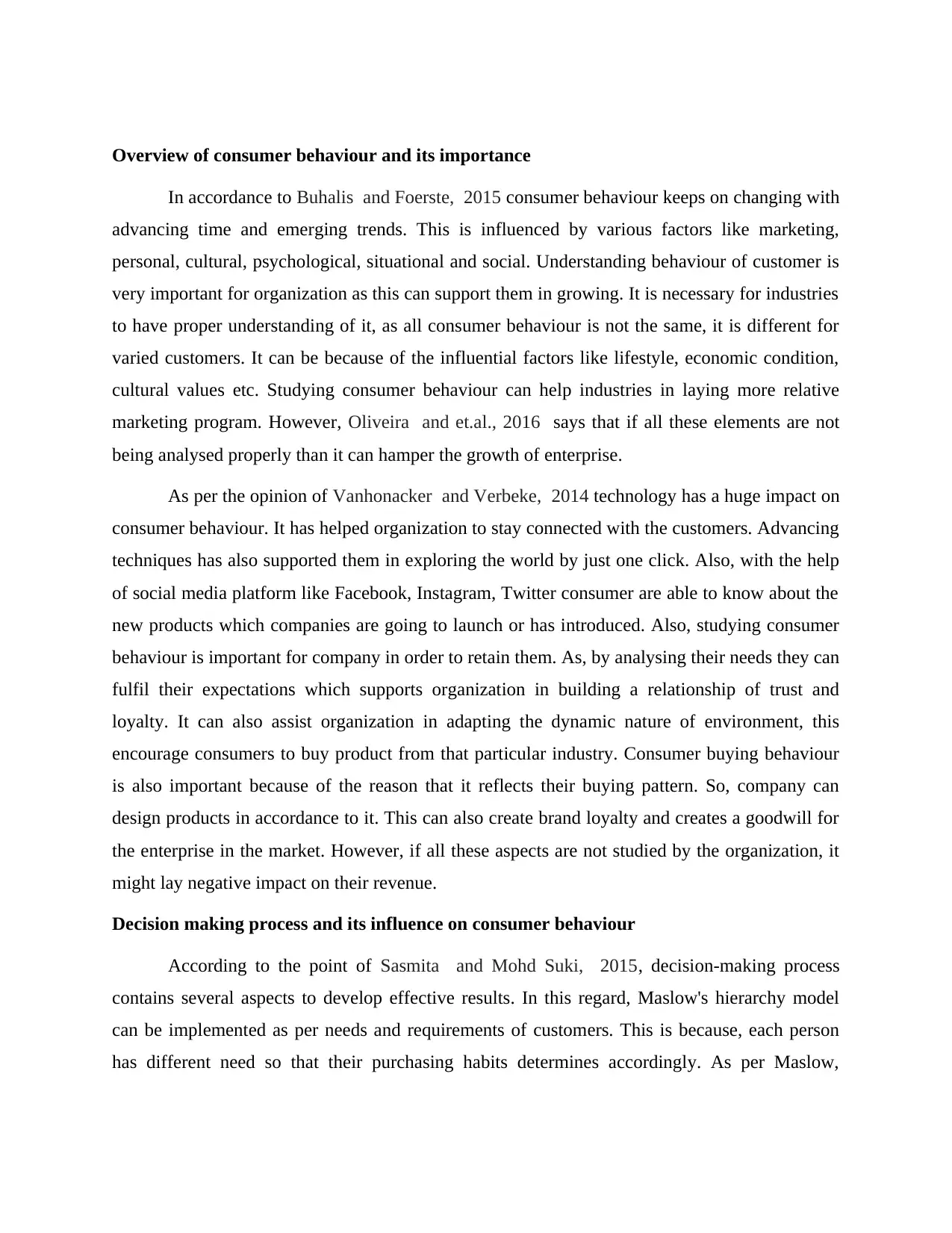
Overview of consumer behaviour and its importance
In accordance to Buhalis and Foerste, 2015 consumer behaviour keeps on changing with
advancing time and emerging trends. This is influenced by various factors like marketing,
personal, cultural, psychological, situational and social. Understanding behaviour of customer is
very important for organization as this can support them in growing. It is necessary for industries
to have proper understanding of it, as all consumer behaviour is not the same, it is different for
varied customers. It can be because of the influential factors like lifestyle, economic condition,
cultural values etc. Studying consumer behaviour can help industries in laying more relative
marketing program. However, Oliveira and et.al., 2016 says that if all these elements are not
being analysed properly than it can hamper the growth of enterprise.
As per the opinion of Vanhonacker and Verbeke, 2014 technology has a huge impact on
consumer behaviour. It has helped organization to stay connected with the customers. Advancing
techniques has also supported them in exploring the world by just one click. Also, with the help
of social media platform like Facebook, Instagram, Twitter consumer are able to know about the
new products which companies are going to launch or has introduced. Also, studying consumer
behaviour is important for company in order to retain them. As, by analysing their needs they can
fulfil their expectations which supports organization in building a relationship of trust and
loyalty. It can also assist organization in adapting the dynamic nature of environment, this
encourage consumers to buy product from that particular industry. Consumer buying behaviour
is also important because of the reason that it reflects their buying pattern. So, company can
design products in accordance to it. This can also create brand loyalty and creates a goodwill for
the enterprise in the market. However, if all these aspects are not studied by the organization, it
might lay negative impact on their revenue.
Decision making process and its influence on consumer behaviour
According to the point of Sasmita and Mohd Suki, 2015, decision-making process
contains several aspects to develop effective results. In this regard, Maslow's hierarchy model
can be implemented as per needs and requirements of customers. This is because, each person
has different need so that their purchasing habits determines accordingly. As per Maslow,
In accordance to Buhalis and Foerste, 2015 consumer behaviour keeps on changing with
advancing time and emerging trends. This is influenced by various factors like marketing,
personal, cultural, psychological, situational and social. Understanding behaviour of customer is
very important for organization as this can support them in growing. It is necessary for industries
to have proper understanding of it, as all consumer behaviour is not the same, it is different for
varied customers. It can be because of the influential factors like lifestyle, economic condition,
cultural values etc. Studying consumer behaviour can help industries in laying more relative
marketing program. However, Oliveira and et.al., 2016 says that if all these elements are not
being analysed properly than it can hamper the growth of enterprise.
As per the opinion of Vanhonacker and Verbeke, 2014 technology has a huge impact on
consumer behaviour. It has helped organization to stay connected with the customers. Advancing
techniques has also supported them in exploring the world by just one click. Also, with the help
of social media platform like Facebook, Instagram, Twitter consumer are able to know about the
new products which companies are going to launch or has introduced. Also, studying consumer
behaviour is important for company in order to retain them. As, by analysing their needs they can
fulfil their expectations which supports organization in building a relationship of trust and
loyalty. It can also assist organization in adapting the dynamic nature of environment, this
encourage consumers to buy product from that particular industry. Consumer buying behaviour
is also important because of the reason that it reflects their buying pattern. So, company can
design products in accordance to it. This can also create brand loyalty and creates a goodwill for
the enterprise in the market. However, if all these aspects are not studied by the organization, it
might lay negative impact on their revenue.
Decision making process and its influence on consumer behaviour
According to the point of Sasmita and Mohd Suki, 2015, decision-making process
contains several aspects to develop effective results. In this regard, Maslow's hierarchy model
can be implemented as per needs and requirements of customers. This is because, each person
has different need so that their purchasing habits determines accordingly. As per Maslow,
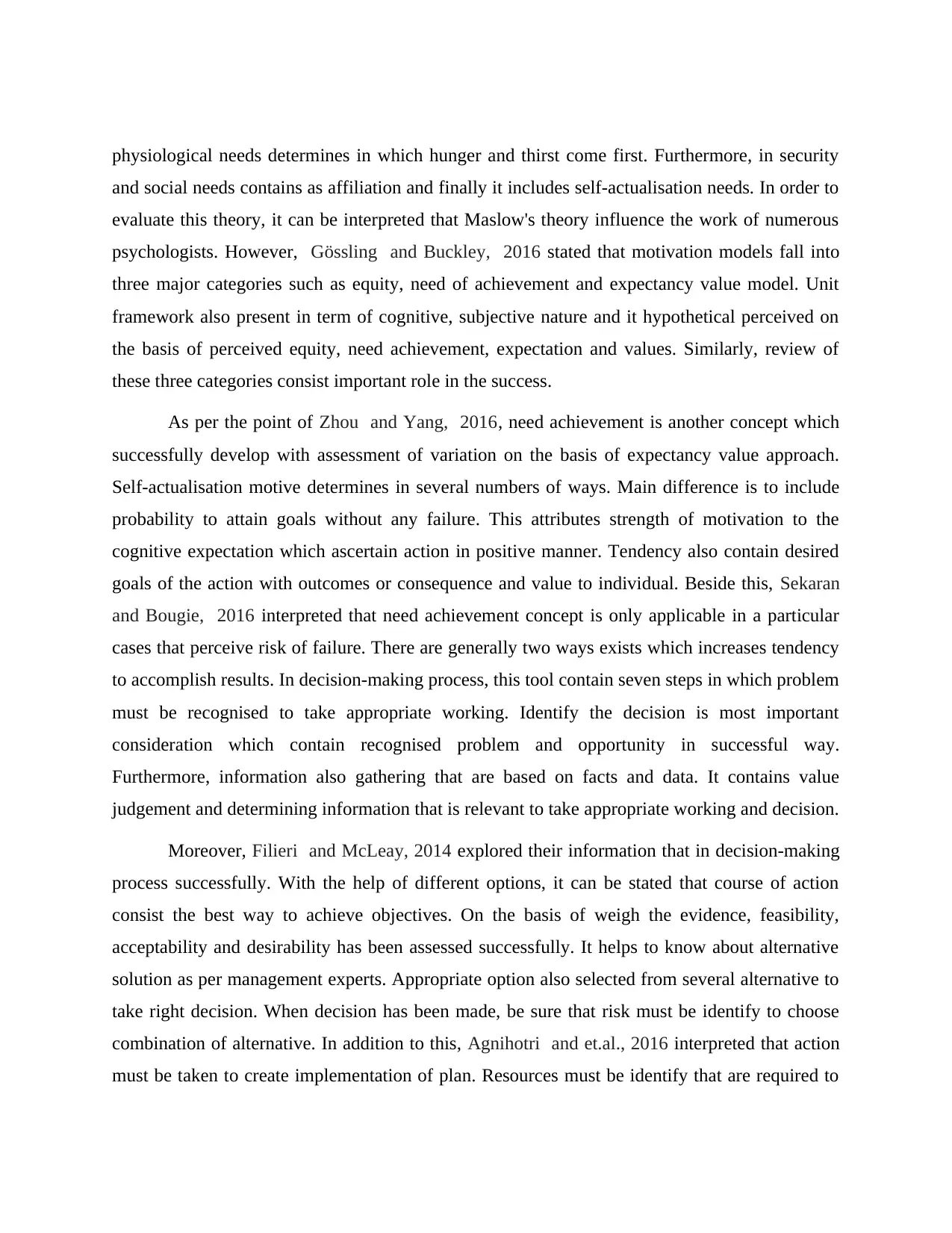
physiological needs determines in which hunger and thirst come first. Furthermore, in security
and social needs contains as affiliation and finally it includes self-actualisation needs. In order to
evaluate this theory, it can be interpreted that Maslow's theory influence the work of numerous
psychologists. However, Gössling and Buckley, 2016 stated that motivation models fall into
three major categories such as equity, need of achievement and expectancy value model. Unit
framework also present in term of cognitive, subjective nature and it hypothetical perceived on
the basis of perceived equity, need achievement, expectation and values. Similarly, review of
these three categories consist important role in the success.
As per the point of Zhou and Yang, 2016, need achievement is another concept which
successfully develop with assessment of variation on the basis of expectancy value approach.
Self-actualisation motive determines in several numbers of ways. Main difference is to include
probability to attain goals without any failure. This attributes strength of motivation to the
cognitive expectation which ascertain action in positive manner. Tendency also contain desired
goals of the action with outcomes or consequence and value to individual. Beside this, Sekaran
and Bougie, 2016 interpreted that need achievement concept is only applicable in a particular
cases that perceive risk of failure. There are generally two ways exists which increases tendency
to accomplish results. In decision-making process, this tool contain seven steps in which problem
must be recognised to take appropriate working. Identify the decision is most important
consideration which contain recognised problem and opportunity in successful way.
Furthermore, information also gathering that are based on facts and data. It contains value
judgement and determining information that is relevant to take appropriate working and decision.
Moreover, Filieri and McLeay, 2014 explored their information that in decision-making
process successfully. With the help of different options, it can be stated that course of action
consist the best way to achieve objectives. On the basis of weigh the evidence, feasibility,
acceptability and desirability has been assessed successfully. It helps to know about alternative
solution as per management experts. Appropriate option also selected from several alternative to
take right decision. When decision has been made, be sure that risk must be identify to choose
combination of alternative. In addition to this, Agnihotri and et.al., 2016 interpreted that action
must be taken to create implementation of plan. Resources must be identify that are required to
and social needs contains as affiliation and finally it includes self-actualisation needs. In order to
evaluate this theory, it can be interpreted that Maslow's theory influence the work of numerous
psychologists. However, Gössling and Buckley, 2016 stated that motivation models fall into
three major categories such as equity, need of achievement and expectancy value model. Unit
framework also present in term of cognitive, subjective nature and it hypothetical perceived on
the basis of perceived equity, need achievement, expectation and values. Similarly, review of
these three categories consist important role in the success.
As per the point of Zhou and Yang, 2016, need achievement is another concept which
successfully develop with assessment of variation on the basis of expectancy value approach.
Self-actualisation motive determines in several numbers of ways. Main difference is to include
probability to attain goals without any failure. This attributes strength of motivation to the
cognitive expectation which ascertain action in positive manner. Tendency also contain desired
goals of the action with outcomes or consequence and value to individual. Beside this, Sekaran
and Bougie, 2016 interpreted that need achievement concept is only applicable in a particular
cases that perceive risk of failure. There are generally two ways exists which increases tendency
to accomplish results. In decision-making process, this tool contain seven steps in which problem
must be recognised to take appropriate working. Identify the decision is most important
consideration which contain recognised problem and opportunity in successful way.
Furthermore, information also gathering that are based on facts and data. It contains value
judgement and determining information that is relevant to take appropriate working and decision.
Moreover, Filieri and McLeay, 2014 explored their information that in decision-making
process successfully. With the help of different options, it can be stated that course of action
consist the best way to achieve objectives. On the basis of weigh the evidence, feasibility,
acceptability and desirability has been assessed successfully. It helps to know about alternative
solution as per management experts. Appropriate option also selected from several alternative to
take right decision. When decision has been made, be sure that risk must be identify to choose
combination of alternative. In addition to this, Agnihotri and et.al., 2016 interpreted that action
must be taken to create implementation of plan. Resources must be identify that are required to
⊘ This is a preview!⊘
Do you want full access?
Subscribe today to unlock all pages.

Trusted by 1+ million students worldwide
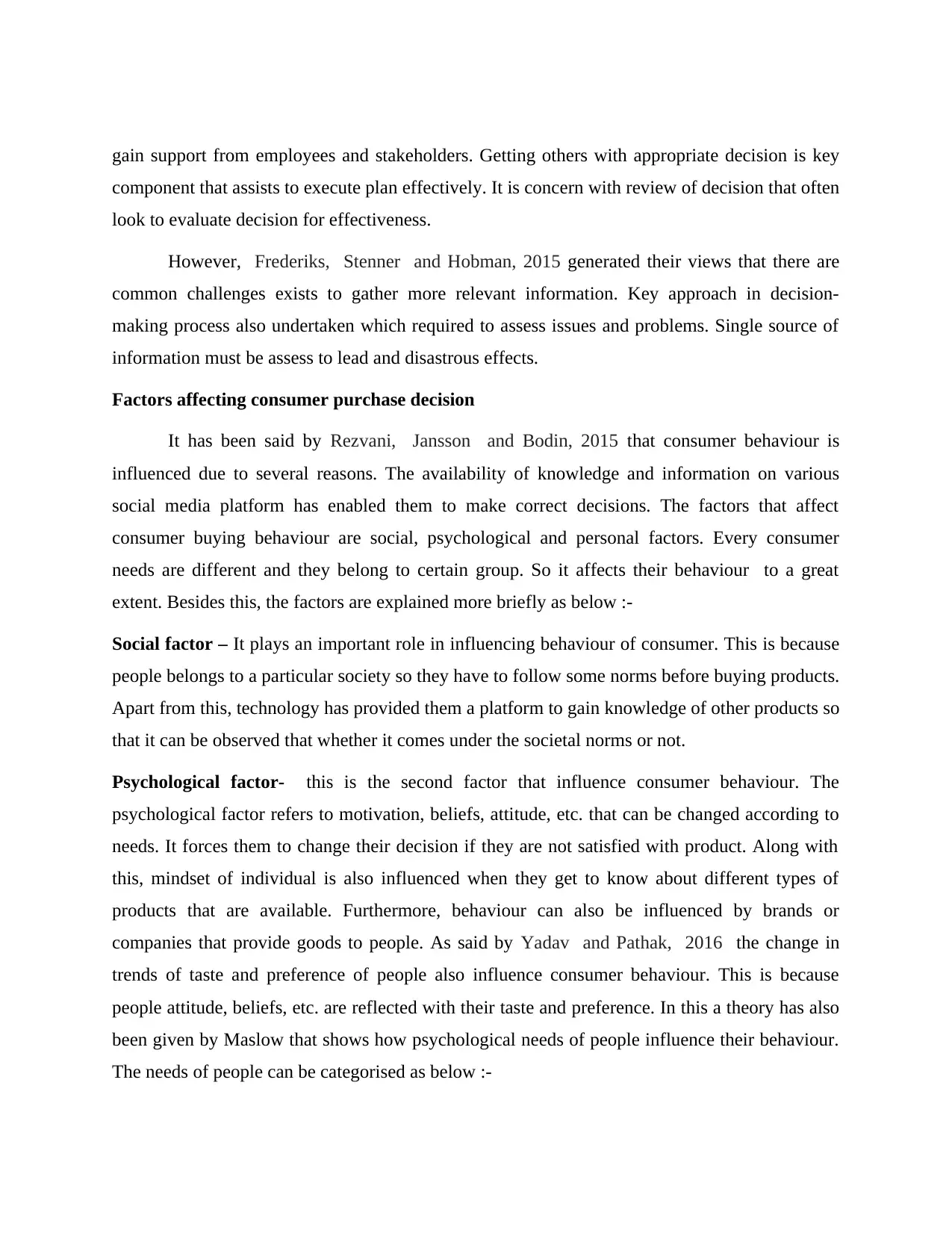
gain support from employees and stakeholders. Getting others with appropriate decision is key
component that assists to execute plan effectively. It is concern with review of decision that often
look to evaluate decision for effectiveness.
However, Frederiks, Stenner and Hobman, 2015 generated their views that there are
common challenges exists to gather more relevant information. Key approach in decision-
making process also undertaken which required to assess issues and problems. Single source of
information must be assess to lead and disastrous effects.
Factors affecting consumer purchase decision
It has been said by Rezvani, Jansson and Bodin, 2015 that consumer behaviour is
influenced due to several reasons. The availability of knowledge and information on various
social media platform has enabled them to make correct decisions. The factors that affect
consumer buying behaviour are social, psychological and personal factors. Every consumer
needs are different and they belong to certain group. So it affects their behaviour to a great
extent. Besides this, the factors are explained more briefly as below :-
Social factor – It plays an important role in influencing behaviour of consumer. This is because
people belongs to a particular society so they have to follow some norms before buying products.
Apart from this, technology has provided them a platform to gain knowledge of other products so
that it can be observed that whether it comes under the societal norms or not.
Psychological factor- this is the second factor that influence consumer behaviour. The
psychological factor refers to motivation, beliefs, attitude, etc. that can be changed according to
needs. It forces them to change their decision if they are not satisfied with product. Along with
this, mindset of individual is also influenced when they get to know about different types of
products that are available. Furthermore, behaviour can also be influenced by brands or
companies that provide goods to people. As said by Yadav and Pathak, 2016 the change in
trends of taste and preference of people also influence consumer behaviour. This is because
people attitude, beliefs, etc. are reflected with their taste and preference. In this a theory has also
been given by Maslow that shows how psychological needs of people influence their behaviour.
The needs of people can be categorised as below :-
component that assists to execute plan effectively. It is concern with review of decision that often
look to evaluate decision for effectiveness.
However, Frederiks, Stenner and Hobman, 2015 generated their views that there are
common challenges exists to gather more relevant information. Key approach in decision-
making process also undertaken which required to assess issues and problems. Single source of
information must be assess to lead and disastrous effects.
Factors affecting consumer purchase decision
It has been said by Rezvani, Jansson and Bodin, 2015 that consumer behaviour is
influenced due to several reasons. The availability of knowledge and information on various
social media platform has enabled them to make correct decisions. The factors that affect
consumer buying behaviour are social, psychological and personal factors. Every consumer
needs are different and they belong to certain group. So it affects their behaviour to a great
extent. Besides this, the factors are explained more briefly as below :-
Social factor – It plays an important role in influencing behaviour of consumer. This is because
people belongs to a particular society so they have to follow some norms before buying products.
Apart from this, technology has provided them a platform to gain knowledge of other products so
that it can be observed that whether it comes under the societal norms or not.
Psychological factor- this is the second factor that influence consumer behaviour. The
psychological factor refers to motivation, beliefs, attitude, etc. that can be changed according to
needs. It forces them to change their decision if they are not satisfied with product. Along with
this, mindset of individual is also influenced when they get to know about different types of
products that are available. Furthermore, behaviour can also be influenced by brands or
companies that provide goods to people. As said by Yadav and Pathak, 2016 the change in
trends of taste and preference of people also influence consumer behaviour. This is because
people attitude, beliefs, etc. are reflected with their taste and preference. In this a theory has also
been given by Maslow that shows how psychological needs of people influence their behaviour.
The needs of people can be categorised as below :-
Paraphrase This Document
Need a fresh take? Get an instant paraphrase of this document with our AI Paraphraser
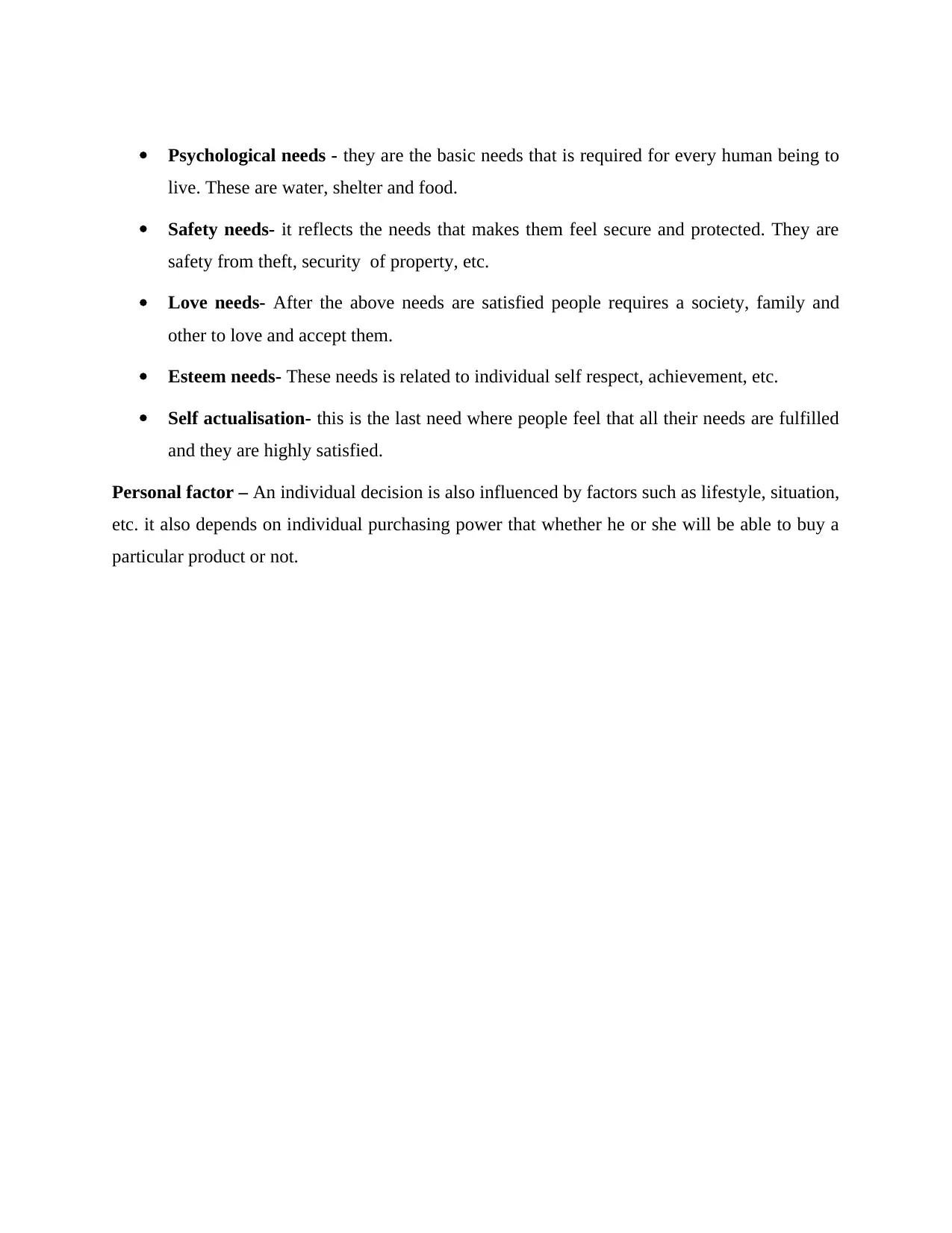
Psychological needs - they are the basic needs that is required for every human being to
live. These are water, shelter and food.
Safety needs- it reflects the needs that makes them feel secure and protected. They are
safety from theft, security of property, etc.
Love needs- After the above needs are satisfied people requires a society, family and
other to love and accept them.
Esteem needs- These needs is related to individual self respect, achievement, etc.
Self actualisation- this is the last need where people feel that all their needs are fulfilled
and they are highly satisfied.
Personal factor – An individual decision is also influenced by factors such as lifestyle, situation,
etc. it also depends on individual purchasing power that whether he or she will be able to buy a
particular product or not.
live. These are water, shelter and food.
Safety needs- it reflects the needs that makes them feel secure and protected. They are
safety from theft, security of property, etc.
Love needs- After the above needs are satisfied people requires a society, family and
other to love and accept them.
Esteem needs- These needs is related to individual self respect, achievement, etc.
Self actualisation- this is the last need where people feel that all their needs are fulfilled
and they are highly satisfied.
Personal factor – An individual decision is also influenced by factors such as lifestyle, situation,
etc. it also depends on individual purchasing power that whether he or she will be able to buy a
particular product or not.
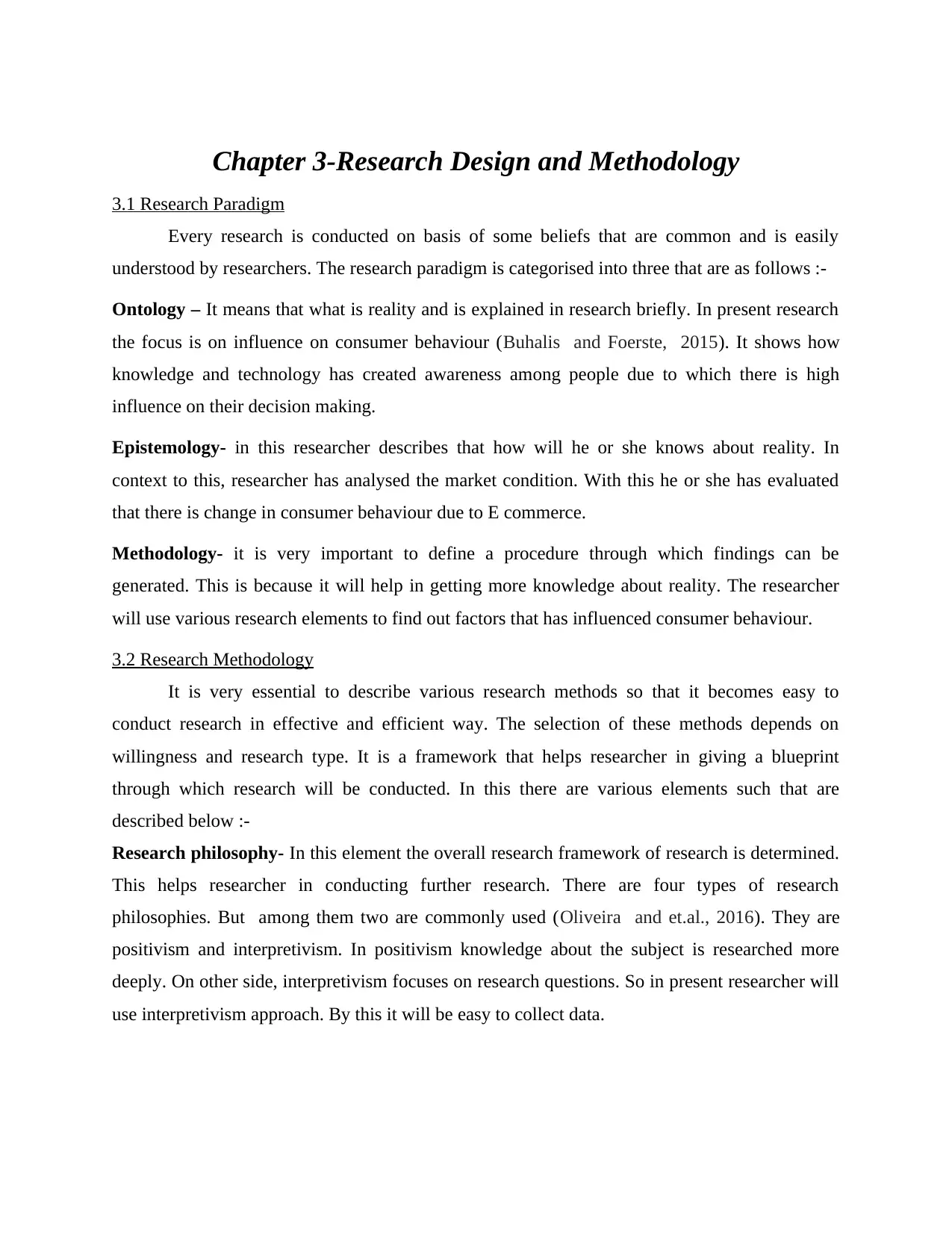
Chapter 3-Research Design and Methodology
3.1 Research Paradigm
Every research is conducted on basis of some beliefs that are common and is easily
understood by researchers. The research paradigm is categorised into three that are as follows :-
Ontology – It means that what is reality and is explained in research briefly. In present research
the focus is on influence on consumer behaviour (Buhalis and Foerste, 2015). It shows how
knowledge and technology has created awareness among people due to which there is high
influence on their decision making.
Epistemology- in this researcher describes that how will he or she knows about reality. In
context to this, researcher has analysed the market condition. With this he or she has evaluated
that there is change in consumer behaviour due to E commerce.
Methodology- it is very important to define a procedure through which findings can be
generated. This is because it will help in getting more knowledge about reality. The researcher
will use various research elements to find out factors that has influenced consumer behaviour.
3.2 Research Methodology
It is very essential to describe various research methods so that it becomes easy to
conduct research in effective and efficient way. The selection of these methods depends on
willingness and research type. It is a framework that helps researcher in giving a blueprint
through which research will be conducted. In this there are various elements such that are
described below :-
Research philosophy- In this element the overall research framework of research is determined.
This helps researcher in conducting further research. There are four types of research
philosophies. But among them two are commonly used (Oliveira and et.al., 2016). They are
positivism and interpretivism. In positivism knowledge about the subject is researched more
deeply. On other side, interpretivism focuses on research questions. So in present researcher will
use interpretivism approach. By this it will be easy to collect data.
3.1 Research Paradigm
Every research is conducted on basis of some beliefs that are common and is easily
understood by researchers. The research paradigm is categorised into three that are as follows :-
Ontology – It means that what is reality and is explained in research briefly. In present research
the focus is on influence on consumer behaviour (Buhalis and Foerste, 2015). It shows how
knowledge and technology has created awareness among people due to which there is high
influence on their decision making.
Epistemology- in this researcher describes that how will he or she knows about reality. In
context to this, researcher has analysed the market condition. With this he or she has evaluated
that there is change in consumer behaviour due to E commerce.
Methodology- it is very important to define a procedure through which findings can be
generated. This is because it will help in getting more knowledge about reality. The researcher
will use various research elements to find out factors that has influenced consumer behaviour.
3.2 Research Methodology
It is very essential to describe various research methods so that it becomes easy to
conduct research in effective and efficient way. The selection of these methods depends on
willingness and research type. It is a framework that helps researcher in giving a blueprint
through which research will be conducted. In this there are various elements such that are
described below :-
Research philosophy- In this element the overall research framework of research is determined.
This helps researcher in conducting further research. There are four types of research
philosophies. But among them two are commonly used (Oliveira and et.al., 2016). They are
positivism and interpretivism. In positivism knowledge about the subject is researched more
deeply. On other side, interpretivism focuses on research questions. So in present researcher will
use interpretivism approach. By this it will be easy to collect data.
⊘ This is a preview!⊘
Do you want full access?
Subscribe today to unlock all pages.

Trusted by 1+ million students worldwide
1 out of 20
Related Documents
Your All-in-One AI-Powered Toolkit for Academic Success.
+13062052269
info@desklib.com
Available 24*7 on WhatsApp / Email
![[object Object]](/_next/static/media/star-bottom.7253800d.svg)
Unlock your academic potential
Copyright © 2020–2025 A2Z Services. All Rights Reserved. Developed and managed by ZUCOL.





